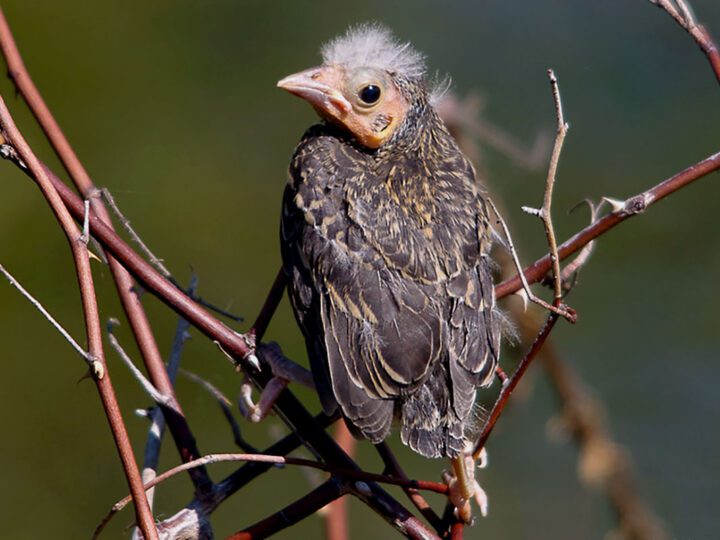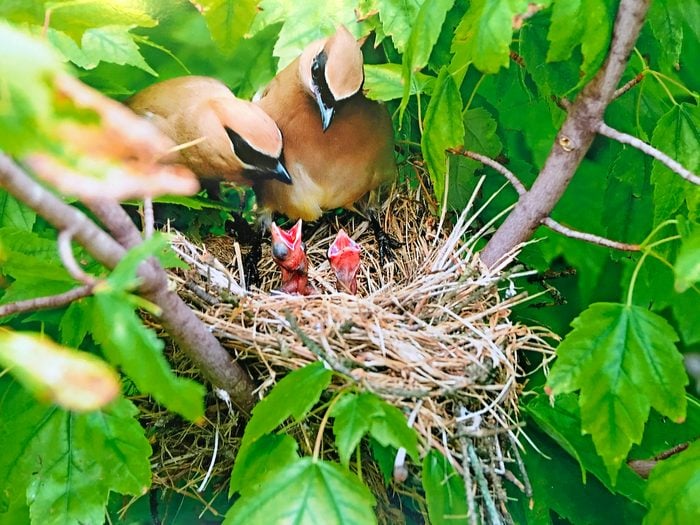Birds typically take 3 to 4 weeks to learn how to fly. The exact time varies among different species.
Bird fledglings leave the nest a few weeks after hatching, embarking on a critical life stage. Their ability to take flight is essential for survival, dictating their independence and future. Parents watch over their young during this vulnerable period, teaching them vital skills.
Each species has its own timeline for this developmental milestone. For instance, altricial birds, which are born blind and featherless, may require longer to develop the necessary flight muscles and feathers compared to precocial birds, which are born more mature. Observing these young aviators as they transition from awkward hops to confident flight offers a fascinating glimpse into the natural world’s wonders. Understanding this process not only satisfies curiosity but also enhances our appreciation for the resilience and adaptability of our feathered friends.

Credit: www.allaboutbirds.org
Table of Contents
Introduction To Avian Development
The journey from birth to flight in birds is a complex process. It involves a series of stages each bird must navigate before soaring the skies. Understanding how birds transform from helpless chicks to confident fliers is fascinating. This development phase is critical to their survival. The growth rate and behavior of birds during this time are remarkable.
Birth To Fledging: A Journey
Newly hatched birds, or chicks, start their lives entirely dependent on their parents. Growth is rapid as they prepare for flight. Fledging marks the stage when a chick is ready to leave the nest.
- Hatching: Chicks break through their shells.
- Feeding: Parents provide nourishment.
- Growing: Feathers and muscles develop.
- Fledging: First attempts at flight begin.
Key Factors Influencing Flight Readiness
Several factors determine when a bird can fly. Each species has unique traits affecting this timeline. Primary factors include:
| Factor | Impact on Flight Readiness |
|---|---|
| Species | Dictates overall development pace. |
| Nutrition | Essential for growth and energy. |
| Environment | Influences safety and learning. |
| Parental Care | Provides support and teaching. |
Each factor plays a crucial role in a bird’s journey to flight. A strong start in life can set the stage for a successful first flight.
Species-specific Flight Milestones
Witnessing the first flight of a young bird is a moment filled with awe. Different species of birds reach this important milestone at their own unique pace. Understanding when various birds take to the skies reveals fascinating insights into their development. Let’s explore the flight milestones of songbirds and raptors, two distinct bird groups.
Songbirds: Early Fliers
Songbirds, known for their melodious calls, are often among the first to spread their wings. Most songbird species fly within two to three weeks after hatching. This rapid development is essential for their survival.
- Robins and canaries typically start to fly at 13-14 days old.
- Chickadees leave the nest by 16 days.
- Sparrows take their first flight between 14 and 16 days.
These early fliers continue to receive care from their parents, improving their flight skills and learning to find food.
Raptors: The Power Of Patience
Raptors, such as eagles, hawks, and owls, take a more measured approach to flight. Their larger body size and complex hunting techniques mean a longer learning curve.
| Raptor Species | Flight Age |
|---|---|
| Eagles | 10-12 weeks |
| Hawks | 6-10 weeks |
| Owls | 9-10 weeks |
Raptor chicks, known as eyasses, first begin with branching. They hop and flutter between branches near their nest. This builds their strength for the big day when they finally soar.
Stages Of Growth In Nestlings
The Stages of Growth in Nestlings are crucial for bird development. These stages ensure birds can eventually fly.
Hatching Out: The First Days
After breaking through their shells, nestlings are fragile and blind. They rely heavily on their parents for warmth and food. This stage is all about gaining strength.
Feathers And Flight Muscles: Preparing For Takeoff
As nestlings grow, so do their feathers and flight muscles. Feathers start as pin feathers, which are essential for eventual flight.
- Week 1-2: Pin feathers emerge.
- Week 3-4: Feathers develop fully.
- Week 5-6: Flight muscles strengthen.
This preparation is vital for their first flight.
Credit: www.quora.com
Nurturing For Flight: Parental Care
The journey from hatchling to a bird soaring the skies involves not just time, but a delicate process of nurturing and care by parent birds. These winged mentors play a crucial role in preparing their young for the challenges of flight. Let’s delve into the parental practices that transform fluffy chicks into confident flyers.
Feeding Regimens For Optimal Growth
Nutrition is key for the robust development of fledglings. Parent birds must find and deliver the right balance of proteins, fats, and vitamins. This ensures their offspring grow strong wings and muscles necessary for flight.
- Worms and insects provide protein for muscle.
- Seeds and berries offer vitamins for overall health.
- Fats from nuts support energy needs.
Frequent meals are vital, especially in the early stages of life. This constant nourishment powers rapid growth.
Teaching And Encouragement: The Role Of Parents
Bird parents don’t just feed their young; they also teach vital skills for survival. This includes flight.
| Activity | Purpose |
|---|---|
| Flapping Exercises | Builds wing strength. |
| Hopping and Jumping | Teaches balance and control. |
| Encouragement to Leave Nest | Instills confidence for the first flight. |
Parent birds demonstrate flying techniques and often coax their chicks to spread their wings with gentle nudges or by leading by example.
The Fledging Process
The journey from nestling to a fully-fledged bird is a thrilling spectacle. The fledging process is when young birds develop the necessary skills to survive outside the nest. This includes growing feathers, gaining strength, and learning to fly. Let’s delve into the exciting stages of this process.
Testing Wings: The First Attempts
Birds begin their flight journey with cautious wing flaps. Nestlings flap their wings vigorously, building muscle. These first attempts are essential for coordination. They often hop around the nest or nearby branches, testing their budding abilities.
- Wing flapping strengthens muscles.
- Branch hopping improves balance.
- Birds learn about lift and air currents.
As days pass, these exercises grow more confident. Young birds might make short, clumsy leaps. Parents watch closely, ensuring safety. This stage sets the foundation for successful flight.
Successful Fledging: The Maiden Flight
The maiden flight marks a pivotal moment. It’s the first time a bird flies from the nest. Successful fledging is both exciting and risky. The young bird must take a leap of faith, trusting its wings to carry it through the air.
- Birds choose a clear, open space for takeoff.
- They often wait for favorable weather conditions.
- Parents may encourage the flight with calls or food.
Once airborne, the new flier experiments with gliding, soaring, and flapping. This maiden flight is short, often ending with a clumsy landing. Yet, it’s a monumental step toward independence. With each flight, young birds gain confidence and skill. Soon, they master the skies, soaring with ease.
Challenges To Early Flight
Birds face many challenges as they learn to fly. Just like toddlers taking their first steps, young birds, or fledglings, must navigate a world full of hazards. Their early attempts at flight are critical for survival, but they come with significant risks.
Predation: The Perils Of Inexperience
Young birds are vulnerable to predators. Their flight skills are not yet fully developed. This makes them easy targets. Predators such as cats, snakes, and larger birds pose a constant threat. Fledglings must quickly learn to fly to escape these dangers.
- Inexperience leads to slower reactions.
- Lack of agility makes evading predators harder.
- Grounded practice sessions expose them to more risks.
Weather And Habitat: Environmental Impacts
Weather conditions greatly affect a fledgling’s ability to fly. Strong winds, rain, and cold can hinder their progress. These elements also impact their energy levels and motivation to practice. The right habitat provides shelter and a safe space for practice.
| Weather Condition | Impact on Fledglings |
|---|---|
| Strong Winds | Make controlling flight difficult |
| Rain | Can weigh down feathers, impeding flight |
| Cold | Reduces energy levels for flight |
Habitat quality is crucial for survival. Dense vegetation offers hiding spots from predators. Open areas are needed for flight practice. Birds must find the right balance in their environment to thrive.
Conservation Efforts For Vulnerable Fledglings
Vulnerable fledglings need time to spread their wings and soar. As these young birds prepare for their first flight, the world around them can be full of challenges. Conservation efforts focus on ensuring that these young birds reach their potential and take to the skies safely. Let’s explore how human actions can support their journey.
Human Impact And Intervention
Humans play a crucial role in the survival of fledglings. Our actions can both harm and help these young birds. Let’s look at ways we can make a positive impact.
- Avoid disturbing nesting areas during breeding season.
- Keep pets indoors or on leashes to prevent attacks.
- Support local wildlife rehabilitation centers.
Creating Safe Spaces For Growth
Safe spaces are essential for fledglings to grow. These areas provide shelter, food, and protection from predators. Here’s how we can create and maintain these vital spaces.
- Plant native shrubs and trees for natural habitats.
- Use bird-friendly building materials to minimize risks.
- Implement bird safety measures in urban spaces.

Credit: www.birdsandblooms.com
Conclusion: The Miracle Of Flight
The miracle of flight in birds amazes us all. From tiny chicks to graceful adults, their journey is nothing short of spectacular. This section celebrates this incredible capability and reflects on what it means for our feathered friends.
Reflecting On Avian Resilience
Birds display remarkable resilience from birth. They endure various challenges before they master the sky. Let’s delve into this resilience:
- Chicks fight for survival from the moment they hatch.
- Learning to fly involves multiple falls and failures.
- Every species adapts uniquely, showing incredible versatility.
These feats highlight the sturdy spirit of birds, urging us to appreciate and learn from their tenacity.
The Future Of Flight: Conservation And Beyond
The ability for birds to fly is crucial for their survival but faces threats from environmental changes and human activities. Here’s what the future could hold:
| Aspect | Impact | Conservation Efforts |
|---|---|---|
| Habitat Loss | Reduces nesting areas | National parks and protected areas |
| Climate Change | Alters migration patterns | Climate action plans |
| Pollution | Affects health | Cleanup campaigns |
With continued efforts in conservation, we hope to secure a future where birds soar high and free. We all play a part in this mission.
Frequently Asked Questions
How Long Do Baby Birds Stay With Their Mother?
Baby birds typically stay with their mother for 2 to 8 weeks, depending on the species. After this period, they are ready to fend for themselves.
How Do Birds Teach Their Babies To Fly?
Parent birds encourage their chicks to fly by nudging them towards the nest’s edge and demonstrating flight themselves. They provide constant support and motivation until the young master the skill.
How Long Until Birds Leave The Nest?
Birds typically leave the nest 2-4 weeks after hatching, depending on the species.
What Happens To Baby Birds When They Leave The Nest?
Baby birds, once they leave the nest, begin their journey of learning to fly, forage, and survive independently in their natural habitat.
Conclusion
As fledglings grow, their journey to the skies begins. Understanding the timeline for avian flight equips bird enthusiasts with key insights. Patience is vital, for each species has its unique pace. Cherish the development stages, from nestling to soaring high.
Let’s marvel as nature takes wing.

